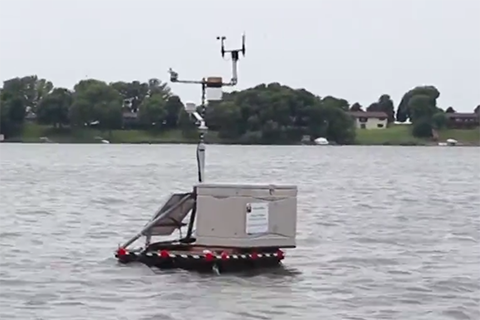Researchers work to understand harmful algal blooms in Minnesota lakes

Researchers at the College of Science and Engineering's St. Anthony Falls Laboratory (SAFL) recently placed a customized data collection buoy in a Minnesota lake to examine lake dymanics and weather patterns that may trigger harmful blue-green algae blooms. These blooms can be dangerous to humans, animals and lake ecosystems, so gaining a better understanding of what causes them can help prevent and minimize them.
Algae are common in surface waters throughout Minnesota. They are microscopic organisms that are a natural part of any aquatic environment. When temperature and water conditions are right, algae, particularly blue-green algae, can form blooms that can grow very rapidly and reach extremely dense populations. Algal blooms can turn the water green and smelly, contribute to fish kills, and at times produce toxins that pose a health risk to people and animals. The Legislative-Citizen Commission on Minnesota Resources (LCCMR) has recently funded research efforts to facilitate the detection and prediction of blue-green algal blooms in Minnesota lakes.
The University of Minnesota algae research group at the St. Anthony Falls Laboratory, led by Professor Miki Hondzo, in collaboration with University of Minnesota Extension, the Minnesota Pollution Control Agency, and the Science Museum of Minnesota, and other partners are investigating what conditions trigger algal blooms in lakes. Starting June 2016, they began using new and advanced water quality monitoring equipment in Madison Lake, Minn., to track the weather, environmental conditions, and lake processes that can produce, sustain, or prevent harmful algal blooms. The research will help researchers better understand how algal blooms develop in our lakes and bring researchers one step closer to algal bloom prediction and prevention.
